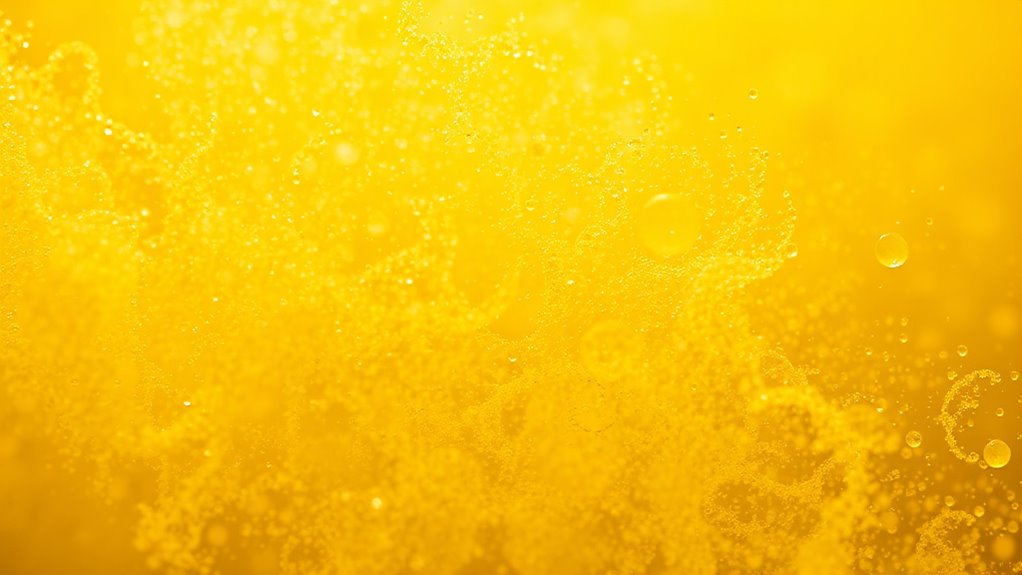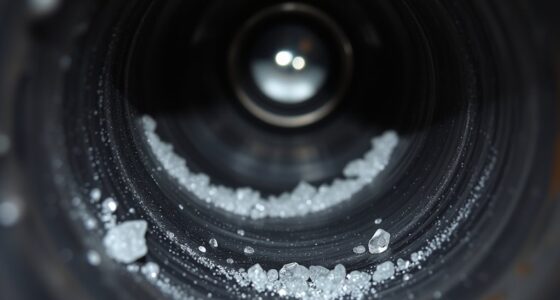Pollen and algae dust may look similar as yellowish particles, but they come from different sources and have distinct features. Pollen is tiny, powdery, and airborne, often causing allergies, especially during flowering seasons. Algae dust forms in water bodies, appearing as slimy, greenish or yellowish clumps or films, usually during warm, nutrient-rich conditions. To tell them apart, focus on their appearance, where they’re found, and environmental clues—you’ll discover more as you go along.
Key Takeaways
- Pollen appears as fine, yellowish, powdery particles from terrestrial plants, while algae dust is granular, often greenish, and related to aquatic environments.
- Pollen is spherical or irregular with textured surfaces and apertures, unlike algae particles, which are irregular, filamentous, or amorphous.
- Pollen settles as uniform dust during flowering seasons, whereas algae dust forms clumps, films, or floating mats on water surfaces.
- Microscopy reveals pollen’s consistent shape with spines or ridges; algae show irregular, filamentous, or colonial structures with smoother surfaces.
- Pollen disperses through wind in dry, warm conditions near land, while algae dust results from blooms in nutrient-rich, warm aquatic environments.
Understanding the Nature of Pollen and Its Role in Allergies
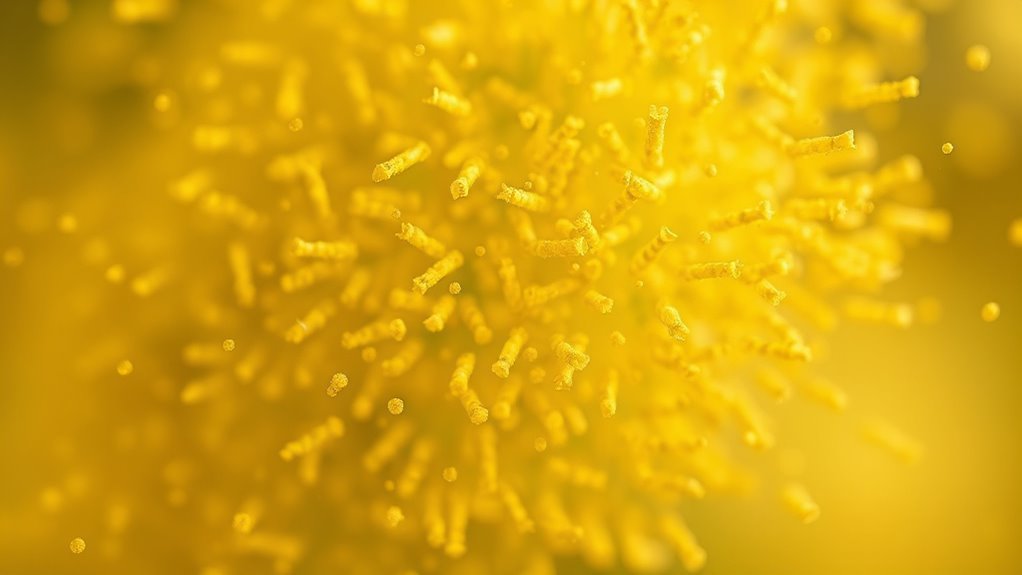
Pollen is a fine powder produced by plants during their reproductive cycle, and it plays a crucial role in plant fertilization. When you encounter pollen in the air, it’s actually tiny particles released from flowers, trees, grasses, and other plants. These particles are lightweight and easily carried by the wind, which is why pollen levels can spike during certain seasons. For many people, pollen isn’t just a nuisance—it triggers allergic reactions. When you breathe in pollen, your immune system may mistakenly see it as a threat, releasing chemicals like histamine. This response causes symptoms such as sneezing, runny nose, itchy eyes, and congestion. Understanding pollen’s role in allergies helps you better manage exposure and reduce allergic reactions during peak seasons. Pollen grains are microscopic and can remain airborne for extended periods, making allergy management challenging.
The Characteristics and Appearance of Algae Blooms

Algae blooms are visible masses of algae that form on the surface of bodies of water, often during warm and nutrient-rich conditions. They typically appear as thick, greenish or bluish layers that can spread across large areas. Depending on the type of algae, the bloom may have a slimy or filmy texture, sometimes forming mats that float or stick to surfaces. Some blooms produce a foul odor, while others are more subtle in smell. You might notice a change in water color, often turning cloudy or murky, with a potential for surface scum or foam. The size and appearance vary, but generally, these blooms create a noticeable, sometimes alarming, visual presence that signals abnormal algal growth in the water. Recognizing these characteristics is important because algae blooms can have a significant spiritual significance in biblical symbolism, representing completeness or divine order.
Visual Differences Between Pollen and Algae Dust

While both pollen and algae dust can settle on surfaces and float through the air, they have distinct visual differences that help you tell them apart. Pollen particles are typically fine, powdery, and often yellow or orange. They tend to be spherical or irregular in shape but are usually small and uniform. Algae dust, on the other hand, appears more granular and may have a slightly thicker or sticky texture. It can look clumpy or stringy, sometimes with a faint greenish or yellowish hue. Additionally, surface contamination caused by these particles varies depending on their physical properties and origin.
The Environmental Conditions That Favor Pollen Dispersal

Environmental conditions such as dry, warm, and windy weather considerably enhance pollen dispersal. When the air is dry, pollen grains are lighter and more easily lifted into the atmosphere. Warm temperatures increase plant activity, leading to more pollen release. Wind acts as a primary dispersal agent, carrying pollen over long distances and spreading it across wide areas. During windy days, pollen can travel hundreds of miles, increasing the likelihood of inhalation or contact. Additionally, low humidity conditions help pollen stay airborne longer, preventing it from clumping or settling quickly. These environmental factors work together to maximize pollen dispersal, making allergy seasons more intense and widespread. Understanding these conditions helps explain why pollen counts are highest during specific weather patterns.
Factors Contributing to Algae Bloom Formation in Water Bodies
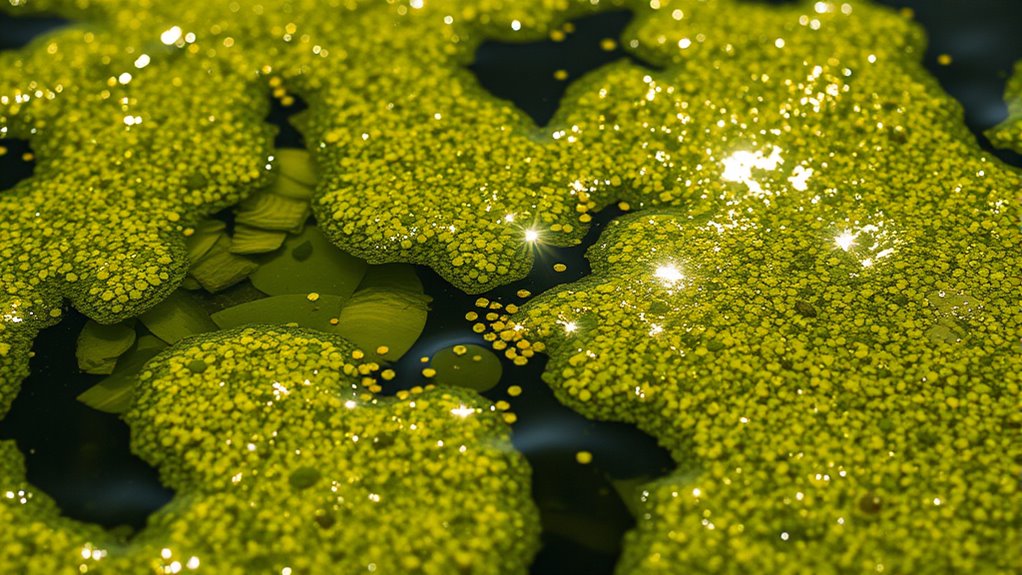
You might notice algae blooms when water bodies have excess nutrients from runoff or pollution. Warm temperatures and increased sunlight also create ideal conditions for algae to thrive. Understanding these factors helps explain why algae can quickly overtake aquatic environments. Additionally, the presence of nutrients in the water significantly accelerates bloom formation, especially when combined with suitable environmental conditions.
Nutrient Overload Effects
Nutrient overload is a primary factor that promotes algae blooms in water bodies. When excess nutrients like nitrogen and phosphorus enter the water, they act as fuel for algae growth. You might notice that after heavy rains or fertilizer runoff, algae populations spike rapidly. These nutrients stimulate rapid cellular division, leading to dense, often visible blooms. As algae proliferate, they consume oxygen, creating dead zones where aquatic life struggles to survive. The imbalance caused by nutrient overload disrupts natural ecosystems, making water less clear and more prone to harmful algal outbreaks. Human activities such as agriculture and wastewater discharge significantly contribute to nutrient overload, which can be exacerbated by poor water management practices. By understanding this, you can see how human activities, such as agriculture and wastewater discharge, considerably contribute to nutrient overload and, consequently, to the formation of algae blooms.
Sunlight and Temperature
After nutrients set the stage for algae growth, environmental conditions like sunlight and temperature determine how rapidly these organisms multiply. Sunlight provides the energy algae need for photosynthesis, so increased exposure accelerates growth. Warmer water temperatures also promote faster reproduction, creating ideal conditions for blooms. When both factors align, algae can quickly dominate a water body. To understand their impact better, consider these points:
- Longer daylight hours boost photosynthesis rates.
- Elevated temperatures shorten algae life cycles.
- Excessive sunlight can lead to rapid blooms, causing oxygen depletion.
- Cooler temperatures slow down algae proliferation, reducing bloom risks.
- Light intensity influences the overall rate of algae growth, with higher levels often leading to more frequent blooms.
Health Impacts of Pollen Versus Algae Dust Exposure

While both pollen and algae dust can trigger health issues, their impacts differ markedly. Pollen often causes allergies, leading to sneezing, itchy eyes, and congestion, especially during peak seasons. If you’re sensitive, exposure can exacerbate asthma symptoms or cause hay fever. Algae dust, however, mainly affects your respiratory system through inhalation of tiny particles that can irritate your lungs. People with pre-existing lung conditions might experience worsened symptoms or difficulty breathing after algae dust exposure. Unlike pollen, algae dust may also carry toxins that can cause more severe reactions if ingested or if inhaled in large quantities. Overall, pollen tends to provoke allergic responses, while algae dust can lead to respiratory irritation and potential toxin-related health issues. Additionally, understanding the health impacts of these airborne particles can help in taking preventive measures to reduce exposure risks.
Methods to Identify and Differentiate Pollen From Algae
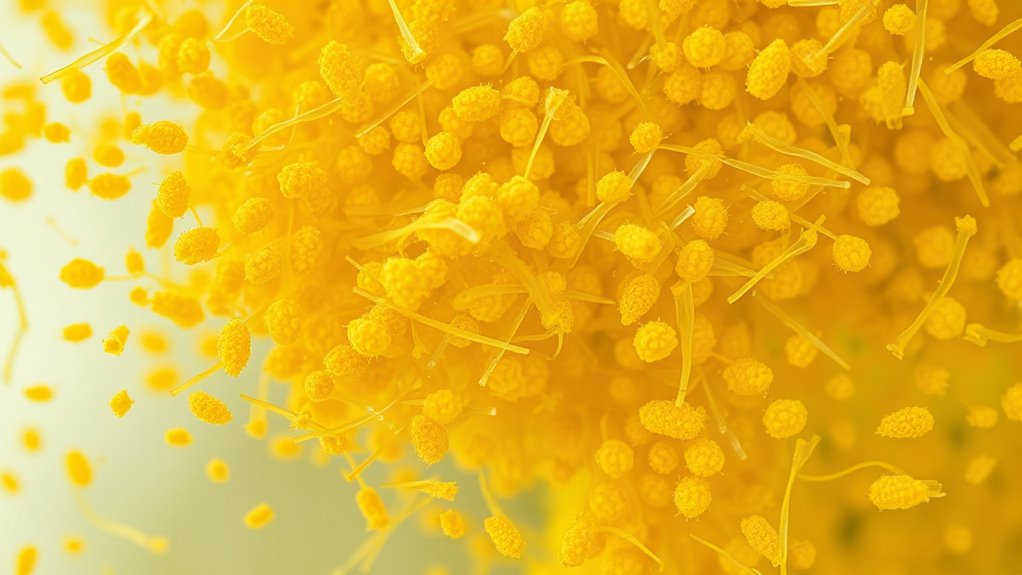
You can tell pollen from algae by examining their visual features and microscopic details. Environmental clues, like where you find them, also help distinguish between the two. Using microscopy and context clues makes identification more accurate and straightforward. Considering factors such as the typical divorce process and legal guidelines can further aid in understanding their origins and differences.
Visual Appearance Differences
To distinguish pollen from algae visually, focus on their unique structural features under a microscope. Pollen grains are typically small, with a smooth or spiky surface, and often have a distinct, rounded or oval shape. They may display apertures or pores that help in identification. In contrast, algae particles tend to be more irregular, often appearing as filaments or clusters with a slimy or granular texture. They usually lack the defined, symmetrical shape of pollen.
- Pollen grains have a consistent shape, often oval or spherical, with textured surfaces.
- Algae are more variable, often filamentous or amorphous.
- Pollen may show apertures or pores, aiding identification.
- Algae tend to be irregular and may appear slimy or granular.
Microscopic Examination Techniques
Using microscopes to examine particles allows you to distinguish pollen from algae effectively. Start with a light microscope to observe size, shape, and surface textures. Pollen grains are typically round or oval with textured exteriors, often featuring spines or ridges. Algae, on the other hand, tend to be more irregular in shape, sometimes filamentous or colonial, with smoother surfaces. Use staining techniques like acetocarmine or iodine to highlight cellular structures, making features like nuclei or cell walls easier to identify. Fluorescence microscopy can also help, as algae often fluoresce under specific dyes due to chlorophyll. By carefully analyzing these microscopic characteristics, you can accurately differentiate pollen from algae, ensuring correct identification of the yellow dust you’re examining. Vetted
Environmental Context Clues
Environmental context provides essential clues for distinguishing pollen from algae in samples. You should consider where the sample was collected, as pollen often originates from terrestrial plants, while algae are aquatic. Look at the surrounding environment: pollen is common near forests, grasslands, or urban areas, whereas algae thrive in ponds, lakes, or slow-moving waters. Additionally, seasonal timing can help; pollen peaks during flowering seasons, while algae blooms often occur in warm, nutrient-rich waters. You can also examine the sample’s physical setting:
- Proximity to vegetation or water bodies
- Presence of other plant debris
- Water temperature and nutrient levels
- Recent weather events influencing pollen dispersal or algae growth
These clues help you differentiate pollen from algae without solely relying on microscopic appearance. AI-powered analysis can further assist in identifying subtle environmental cues that distinguish between these two substances.
Tips for Managing Exposure During Pollen and Algae Seasons
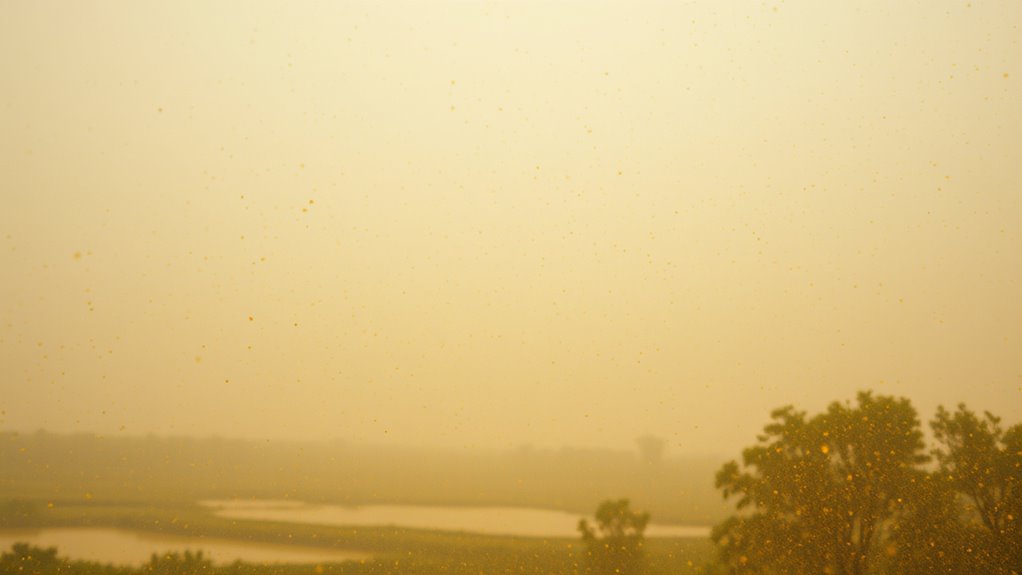
During peak pollen and algae seasons, staying ahead of exposure can markedly reduce allergy symptoms. Check daily pollen and algae forecasts to plan outdoor activities during low-count times, typically early mornings or late evenings. Keep windows and doors closed to prevent outdoor particles from entering your home or car. Use high-efficiency particulate air (HEPA) filters indoors to improve air quality. When outside, wear sunglasses and a hat to shield your eyes and face from dust. Consider wearing a mask if you’ll be exposed for extended periods. Shower and change clothes after outdoor activities to remove pollen and algae spores. Keep outdoor surfaces clean and dry to prevent dust accumulation. Staying informed and taking these proactive steps can help you manage symptoms and enjoy the season with less discomfort.
Frequently Asked Questions
Can Pollen and Algae Dust Cause Similar Respiratory Symptoms?
Yes, pollen and algae dust can cause similar respiratory symptoms. When you breathe in these tiny particles, they irritate your airways, leading to coughing, sneezing, congestion, and even asthma-like symptoms. Both can trigger allergic reactions, especially if you’re sensitive or allergic to them. Keep an eye on air quality reports and take precautions like wearing masks or staying indoors during high pollen or algae dust days to protect your respiratory health.
Are There Specific Seasons When Pollen Is More Prevalent Than Algae?
Think of spring as the grand stage for pollen, when it’s most prevalent, filling the air like a yellow haze. You’ll find pollen peaks from late winter through early summer, especially in warm, dry weather. Algae, on the other hand, flourishes in warmer months, often in late summer or early fall, particularly in water-rich areas. So, if you’re sensitive, expect pollen in spring and algae in late summer or fall.
How Do Weather Changes Influence Pollen and Algae Dust Levels?
Weather changes markedly influence pollen and algae dust levels. Warm, dry, and windy conditions increase pollen dispersal because plants release more spores and pollen during these times. Conversely, heavy rain and humidity tend to suppress pollen but can boost algae growth by providing the moisture they need. Sudden temperature shifts can also trigger spikes in both, making it essential to monitor weather patterns to anticipate dust levels.
Can Pollen or Algae Dust Be Harmful to Pets and Wildlife?
Sure, pollen and algae dust might seem harmless, but they can actually irritate your pets and wildlife. Allergies, sneezing, and respiratory issues aren’t just human problems—they affect animals too. If you love your furry friends or care about local wildlife, keep an eye out for excessive dust in the air. Clean regularly, limit exposure, and consult your vet or wildlife expert if symptoms appear. After all, everyone deserves to breathe easy.
What Are Effective Methods to Reduce Indoor Pollen and Algae Dust?
You can reduce indoor pollen and algae dust by keeping windows closed during high pollen seasons and using air purifiers with HEPA filters. Regularly clean surfaces and vacuum with a HEPA filter to trap dust particles. Shower and change clothes after outdoor activities to prevent bringing in pollen. Maintain low humidity levels to discourage algae growth, and consider using air conditioners that filter indoor air, helping you breathe easier and minimize dust buildup.
Conclusion
Now that you know the difference between pollen and algae dust, you can confidently spot these yellow nuisances and protect yourself. Whether it’s the invisible, allergy-triggering pollen or the eye-catching algae blooms, understanding their signs helps you avoid their sneaky health impacts. Stay vigilant during peak seasons—these yellow specks can turn your environment into a battleground. With the right knowledge, you’ll keep these tiny invaders at bay and breathe easier every day.
